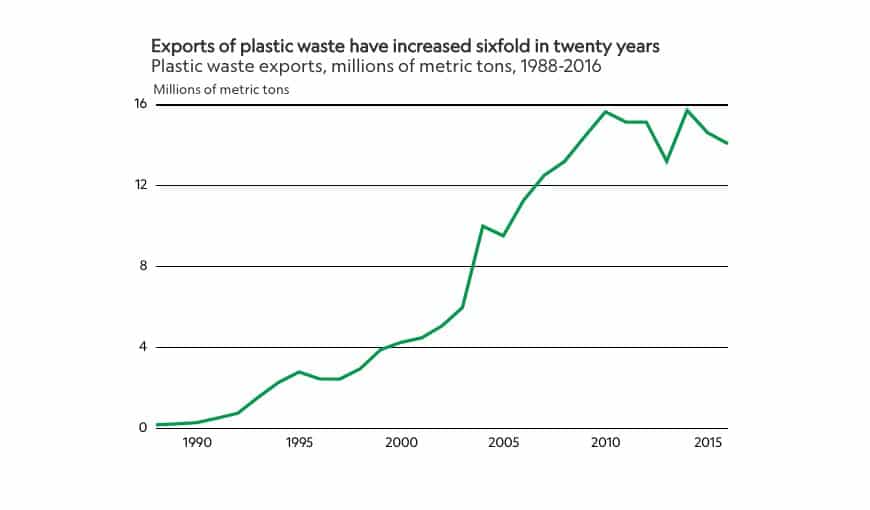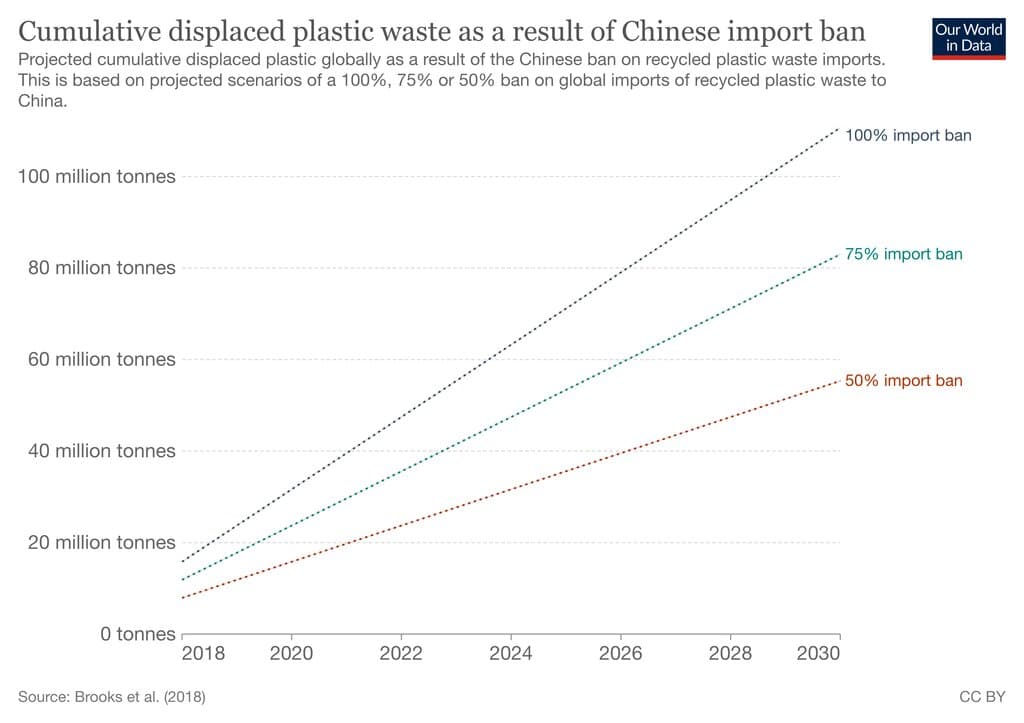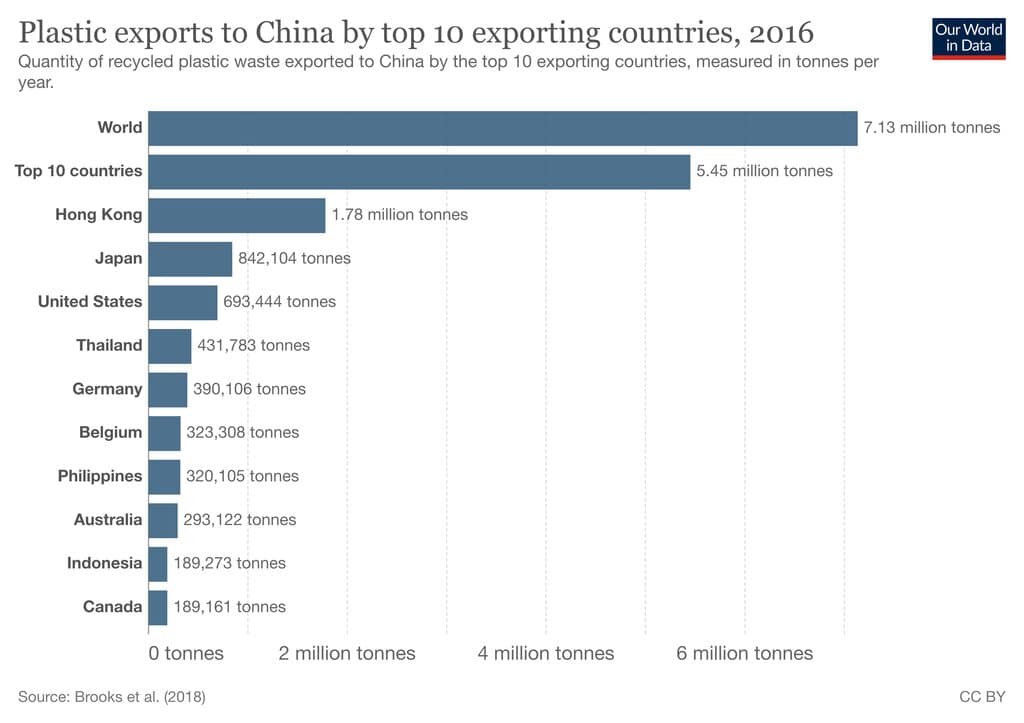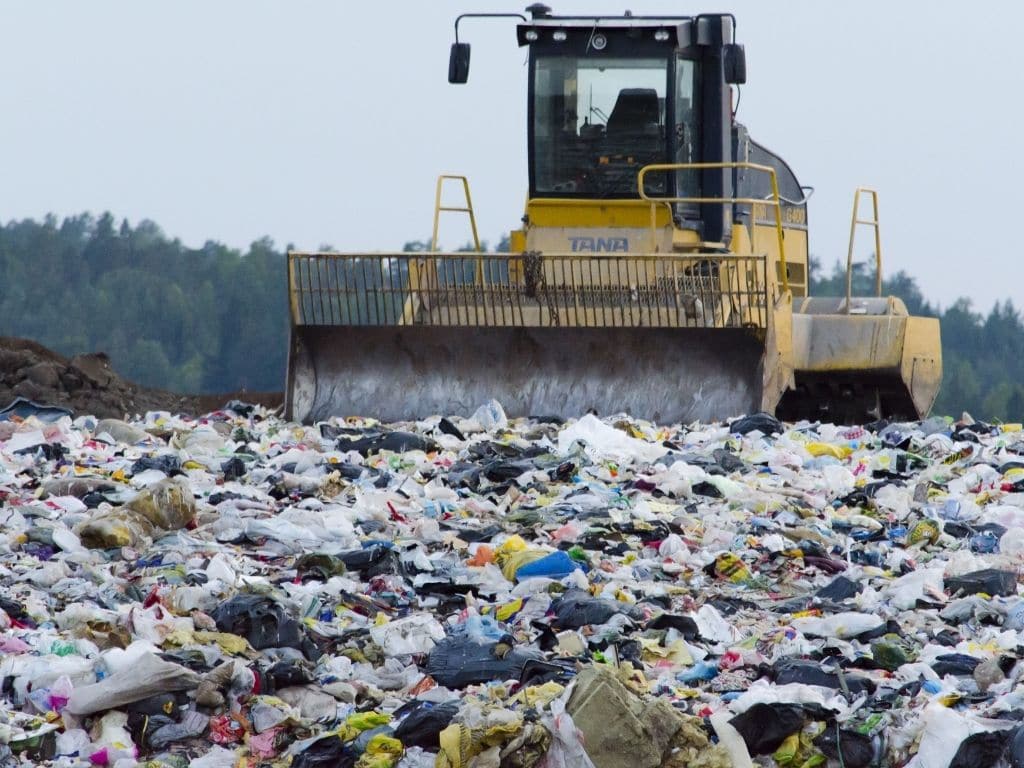China is the world’s biggest producer and consumer of plastics. For more than two decades, the country was also the dumping ground for foreign nations’ trash as the world’s largest importer. In 2017, the year before China’s strict import ban came into effect, the country imported almost 600,000 metric tons of plastic waste. We take a look at the reasons for the ban and its rippling effects on global plastic management.
—
Plastic pollution has plagued China for decades. The country is currently the world’s largest plastic manufacturer with a yearly average of 60 million tons – of which only about 30% is recycled. It also accounts for nearly one-third of the global single-use and virgin plastics production.
Up until 2017, China was also the largest importer of plastic. Between 2010 and 2016, it imported on average 8 million tonnes of plastic from more than 90 nations around the world. In 2016, the highest amount of plastic exports came from Hong Kong – by far the world’s largest exporter to mainland China with nearly 2 million tonnes – Japan, and the United States. Among the many Western European countries sending their plastic waste to China, Germany topped the list with around 390,000 tonnes per year. These imports contributed to an additional 10 to 13% of plastic waste to the already huge amount that China has been struggling to deal with in recent years.

Exports of Plastic Waste Worldwide, 1988-2016. Image: National Geographic.
Why Did China Import So Much Plastic Waste?
The waste export trend began sometime between the 1980s and 1990s, when China started to take in plastic and other scraps from less economically developed areas to use as raw materials for processing and manufacturing, and to make up for a shortage of domestic resources. It was a win-win situation.
On the one hand, Chinese businesses finally had access to high-quality raw materials. On the other hand, exporting countries took advantage of this substantially cheaper way of dealing with their trash. The imports boomed at the beginning of the new century after China joined the World Trade Organization in 2001. Opening up to international businesses, China saw a dramatic increase in its demand for raw materials due to rapid industrial development.
Several studies proved the advantages of importing recyclable waste, from saving energy, since less production of similar materials from virgin natural resources is required, to guaranteeing a stable supply of high-quality materials and generating high returns for the importing nation’s recycling industry. However, there were also several downsides to it, most notably the environmental repercussions of dealing with such huge amounts of waste. For China, the waste-recycling industry that once contributed to the prosperity and rapid industrialisation of the country had now turned into a low-profit and low-value enterprise. Furthermore, the industry became largely responsible for a massive increase in air and water pollution across the country, a problem that was already out of control. If the country wants to keep its promise to reach carbon neutrality by 2060, emissions need to be drastically reduced and this needs to happen fast. One way to do it is by addressing the issue of plastic pollution. With several interventions and a long-awaited import ban, China is hoping to cut emissions and get a step closer to net-zero.
You might also like: China and its Plastic Pollution Crisis
What Does China’s Ban on Plastic Imports Entail?
In 2017, the Chinese government announced an import ban on solid waste including several types of plastics and other recyclable waste. The 24-item list of materials initially prohibited from entering China included eight types of post-consumer plastic scrap, one type of unsorted paper, a dozen types of used textiles, and four metal slags containing vanadium.
The import ban came into effect on January 1, 2018. However, just two months later, the Chinese government announced an even tighter policy that severely reduced the contamination levels that would be allowed on a number of scrap material imports, an amount so low that basically turned this policy into another ban. According to customs data, the move halved imports of solid waste and nearly ceased imports of scrap plastic in 2018. At the end of 2019, China added another 16 materials to the list, only to announce the following year a ban on all imports of solid waste as well as on dumping, stacking, and disposal of waste products from abroad.
Starting on January 1, 2021, the Ministry of Ecology and Environment stopped issuing import licenses from overseas as part of a series of policies to tackle pollution and force the industry to improve processing. In the same year, China launched a five-year action plan to facilitate the phase-out of manufacturing and circulation of single-use plastics – which are almost entirely made from fossil fuels – while promoting alternatives and boosting recycling. The government introduced several new policies targeting plastic shopping bags and the use of disposable plastics in restaurants.
How Is China’s Import Ban Affecting Countries Around the World?
While the country’s import ban will most likely have a positive impact on Chinese environmental sustainability in the long run by increasing the prospects of mitigation of carbon footprint and plastic waste trade flow worldwide, it also had some dramatic repercussions on countries that highly depended on China to manage their waste. The decision to ban all imports of plastic waste and other recyclables caused immediate and widespread repercussions and huge problems for the global recycling industry. When the ban was introduced, experts estimated that over 100 million metric tons of plastic waste would be displaced because of the policy by 2030. The Chinese government’s decision would also have an impact on more than 676,000 metric tons of waste, worth about USD$278 million.

Cumulative Displaced Plastic Waste as a Result of Chinese Import Ban. Image: Our World in Data.
Countries like the United States – which was exporting around 4,000 shipping containers of garbage to China every day before the ban came into effect – rerouted most of their shipments to Southeast-Asian nations such as Thailand, Vietnam, and Malaysia. However, when the latter became overwhelmed, it decided to follow China’s strategy and clamp down on waste imports. Indeed, countries around the world – some of which already lacked the adequate infrastructure to manage their own waste – were unprepared to take in such large amounts of trash produced by the rest of the world. As more import markets stopped accepting waste, exporting nations around the world began to accumulate massive quantities.
The US is not the only country to pay the price for the import ban. The decade-long reliance on China has stifled the development of the domestic market and infrastructure for waste management in many European countries as well, including Germany and Belgium. The lack of adequate recycling plants has not only forced many of them to find other markets to export their trash, but it also increased their incineration rates. In England, for example, burned waste was up by 665,000 tonnes in 2019.

Plastic exports to China by top 10 exporting countries, 2016. Image: Our World in Data.
However, in the long run, China’s ban could have positive consequences for other nations.
First and foremost, Western countries would finally be forced to find their own way to manage the garbage they generate instead of relying on the help of third countries, with experts predicting an overhaul of waste disposal systems. Furthermore, the new ‘receiving’ countries, like many developing nations in Southeast Asia, could eventually benefit from the increasing flow of cheap recyclable materials, which were the key to China’s successful industrial development at the beginning of the century.
Main Takeaways
As China tackles plastic pollution at home, its actions – for now – feed the scourge globally. While there is still not enough proof that China’s strategies to reduce the overall amount of plastic – from prohibiting waste imports to phasing out single-use plastics in businesses – are benefiting the country, experts are worried about the repercussions that these decisions are having everywhere else.
It is true, however, that, as the global leader in plastic production and one of the most polluting countries in the world, China had to take action now. And so should other countries. Waste is the fourth-largest sector of emissions and plastic alone is set to generate more carbon emissions than coal by 2030, making plastic pollution one of the biggest environmental problems of our lifetime. While the immediate repercussions of China’s policies are devastating for nations around the world, the ban will also force them to find new ways to deal with their own waste and implement new policies aimed at reducing overall plastic circulation. If nothing else, China is finally acting to tackle a huge, global issue. What are other countries’ long-term plans in terms of waste management?
You might also like: 8 Shocking Plastic Pollution Statistics to Know About


















